| Article ID | Journal | Published Year | Pages | File Type |
|---|---|---|---|---|
| 10702012 | Icarus | 2005 | 14 Pages |
Abstract
Measurements of the vertical and latitudinal variations of temperature and C2H2 and C2H6 abundances in the stratosphere of Saturn can be used as stringent constraints on seasonal climate models, photochemical models, and dynamics. The summertime photochemical loss timescale for C2H6 in Saturn's middle and lower stratosphere (â¼40-10,000 years, depending on altitude and latitude) is much greater than the atmospheric transport timescale; ethane observations may therefore be used to trace stratospheric dynamics. The shorter chemical lifetime for C2H2 (â¼1-7 years depending on altitude and latitude) makes the acetylene abundance less sensitive to transport effects and more sensitive to insolation and seasonal effects. To obtain information on the temperature and hydrocarbon abundance distributions in Saturn's stratosphere, high-resolution spectral observations were obtained on September 13-14, 2002 UT at NASA's IRTF using the mid-infrared TEXES grating spectrograph. At the time of the observations, Saturn was at a LSâ270°, corresponding to Saturn's southern summer solstice. The observed spectra exhibit a strong increase in the strength of methane emission at 1230 cmâ1 with increasing southern latitude. Line-by-line radiative transfer calculations indicate that a temperature increase in the stratosphere of â10K from the equator to the south pole between 10 and 0.01 mbar is implied. Similar observations of acetylene and ethane were also recorded. We find the 1.16 mbar mixing ratio of C2H2 at â1° and â83° planetocentric latitude to be 9.2â3.8+6.4Ã10â7 and 2.5â1.0+1.8Ã10â7, respectively. The C2H2 mixing ratio at 0.12 mbar is found to be 1.0â0.3+0.5Ã10â5 at â1° planetocentric latitude and 2.6â0.9+1.3Ã10â6 at â83° planetocentric latitude. The 2.3 mbar mixing ratio of C2H6 inferred from the data is 7.5â1.7+2.3Ã10â6 and 1.0â0.2+0.3Ã10â5 at â1° and â83° planetocentric latitude, respectively. Further observations, creating a time baseline, will be required to completely resolve the question of how much the latitudinal variations of C2H2 and C2H6 are affected by seasonal forcing and/or stratospheric circulation.
Related Topics
Physical Sciences and Engineering
Earth and Planetary Sciences
Space and Planetary Science
Authors
Thomas K. Greathouse, John H. Lacy, Bruno Bézard, Julianne I. Moses, Caitlin A. Griffith, Matthew J. Richter,
